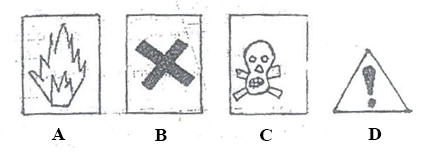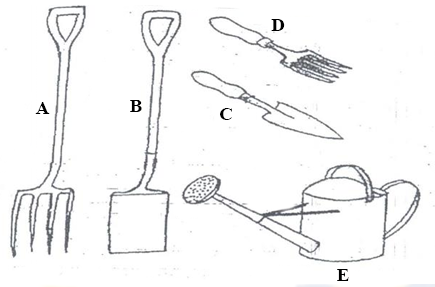1.
An example of a noble gas is
chlorine
neon.
nitrogen.
oxygen.
2.
The structure that stores sperms temporarily in the male reproductive system of humans is
epididymis.
scrotal disc.
sperm duct.
testes.
3.
Which of the following properties of alcohol as a thermometric liquid is correct?
It is opaque.
It does not wet glass.
It has a very flow freezing point.
It has a high freezing point.
4.
In which of the following vegetation of Ghana does millet and sorghum grow well?
Costal savannah
Forest zone
Guinea savannah
Transition zone
5.
Which of the following methods is/are used for preserving fish?
I. Canning
II. Frying
III. Smoking
I only
I and II only
II and III only
I, II and III
6.
Which of the following practices in the home can prevent disease infection?
Covering one's food
Drinking unclean water
Keeping one's surrounding untidy
Sharing towels and sponges
7.
An example of a semimetal is
calcium.
lithium.
silicon.
sodium.
8.
What kind of energy transformation takes place in an electric motor?
Chemical energy to electrical energy
Chemical energy to mechanical energy
Electrical energy to light energy
Electrical energy to mechanical energy
9.
Landrace is a breed of
cattle.
goats.
pigs.
sheep.
10.
In flowering plants, the stamen is made up of
anther and stigma.
anther and filament.
stigma and filament.
stigma and style.
11.
Which of the following statements about a transistor is correct?
It can be used to amplify current.
It is similar to three diodes.
It consists of two leads only.
It has three junctions.
12.
An atom has 6 protons and 7 neutrons in its nucleus. What is the mass number?
1
6
7
13
13.
A record of daily activities on a farm is termed
labour record.
inventory record.
farm diary.
production record.
14.
Which of the following devices work(s) on the principle of transmission pressure in fluids?
I. Water pumps
II. Syringes
III. Bicycle brakes
I only
I and II only
II and III only
I, II and III
15.
Which of the following crops is not correctly matched with its group?
Cowpea - cereal crop
Cocoa - beverage crop
Coconut - oil crop
Cocoyam - tuber crop
16.
Which of the following substances is a salt?
H2SO4
NaOH
HCl
CaCl2
17.
In which part of the digestive system of a fowl does grinding of feed take place?
Crop
Gizzard
Oesophagus
Proventriculus
18.
The parts of a bony fish that are used to control the level at which the fish swims are known as
dorsal and caudal fins.
caudal and pectoral fins.
pectoral and pelvic fins.
dorsal and pectoral fins.
19.
Millon's reagent is used to test for
carbohydrates.
fats.
proteins.
vitamins.
20.
In an n-p-n transistor, the n-type collector is connected to the positive terminal of the battery thus making the
base-collector junction reverse biased.
base-collector junction forward biased.
base-emitter junction reverse biased.
base-emitter junction forward biased.
21.
Which type of vegetation favours both wet and hot environmental conditions?
Strand and mangrove
Coastal savannah
Guinea savannah
Tropical forest
22.
During drought, some plants dry out because of high
I. atmospheric temperature
II. humidity
III. rate of evaporation
III only
I and II only
I and III only
I, II and III
23.
Soil erosion on sloppy farmlands is best controlled by
cover cropping.
mulching.
strip cropping.
terracing.
24.
A viable seed is one that
germinates under suitable conditions.
contains oil.
develops from fertilized ovary.
has a pericarp.
25.
Which of the following pairs of structures form part of the female reproductive system of humans?
Urethra and uterus
Cervix and uterus
Ureter and uterus
Cervix and ureter
26.
Which of the following chemical symbols is that of a metal?
Ca
Ne
P
S
27.
All the living and non-living things that surround an organism constitute its
community.
ecosystem.
environment.
habitat.
28.
Which of the following crops should be planted after cassava in crop rotation?
Cocoyam
Cowpea
Onion
Yam
29.
Endoparasites in farm animals can be controlled by
drenching.
dipping.
dusting.
spraying.
30.
Which of the following devices requires the use of transistors in its operation?
Computer
Electric heater
Microphone
Wall clock
31.
Feel Method is used to determine soil
air.
colour.
structure.
texture.
32.
Which of the following modes of heat transfer is the thermos flask designed to minimize?
I. Conduction
II. Convection
III. Radiation
I and II only
I and III only
II and III only
I, II and III
33.
An atom of an element is represented as 1225 X. What is the respective number of neutrons and protons in the atom?
12 and 13
12 and 25
13 and 12
25 and 12
34.
The anemometer is an instrument used in determining
amount of rainfall.
speed of wind.
relative humidity.
intensity of light.
35.
Which of the following subjects is/are considered as applied science?
I. Biology
II. Medicine
III. Psychology
I only
I and II only
I and III only
II and III
36.
Chinchilla is a breed of
goats.
pigs.
rabbits.
sheep.
37.
Which of the following characters is not acquired through heredity?
Language spoken
Shape of nose
Colour of eyes
Temperament
38.
The food nutrient which ensures good health in farm animals is
carbohydrates.
minerals.
proteins.
vitamins.
39.
The use of resistant breeds of farm animals to control pests is a
biological method.
chemical method.
cultural method.
physical method.
40.
Which of the following arrangements show the correct order of increasing complexity of structures in living organisms.
cells → organs → tissues → systems
cells → tissues → organs → systems
cells → systems → tissues → organs
cells → tissues → systems → organs
a)
In an experiment to demonstrate a property of light, three cardboards, A, B, and C with holes in their centres are arranged in a straight line between a lighted bulb and an observer as shown in the illustration below.
Study the illustration carefully and use it to answer the question that follow:

i)
What would the observer see from the position shown?
ii)
What would the observer see when cardboard B is slightly displaced from the line?
iii)
Explain the observation made in (a) (ii) above.
iv)
What would be observed when the cardboard B is brought back to its original position?
v)
What property of light is being demonstrated in this experiment?
vi)
Mention
α)
two natural occurrences that could be explained by the property of light demonstrated.
β)
one device that works on the property of light demonstrated.
b)
The diagrams below are illustrations of hazards symbols found in everyday life.
Study them carefully and use them to answer the questions that follow:

i)
What does each symbol A, B, C and D represent?
ii)
Name one substance each that is associated with each of the symbols A, B and C.
iii)
Name one place where the symbols D can be found.
iv)
State two advantages of hazard symbols.
c)
The diagrams below are illustrations of the different types of teeth in humans.
Study them carefully and use them to answer the questions that follow:

i)
Identify each type of teeth labelled A, B and C.
ii)
Describe the shape of each of the teeth labeled A, B and C.
iii)
State one function of each of the teeth labeled A, B and C.
iv)
Name the parts of the teeth labeled I and II.
d)
The diagrams below are illustrations of some farm tools.
Study them carefully and use them to answer the questions that follow:

i)
Identify each of the following labeled A, B, C, D and E.
ii)
Mention one use of each of the tools labeled A, B, C, D and E.
a)
i)
What are ruminants?
ii)
Give two examples of ruminants.
b)
i)
What is force?
ii)
State two effects of forces on the body.
c)
i)
Mention two ways in which the carbon cycle can be maintained.
ii)
State one environmental effect when the carbon cycle is disrupted.
d)
i)
Mention the three sub-atomic particles.
ii)
State the relative charge on each of the three sub-atomic particles mentioned in (d) (i) above.
iii)
Name the particle formed when an atom loses an electron.
a)
i)
What is a mixture?
ii)
Explain why some mixtures are thoroughly stirred before they are used.
b)
i)
What is reflection of light?
ii)
State two characteristics of the images formed by plane mirrors.
c)
i)
What is a fertilizer?
ii)
Give one example of an inorganic fertilizer.
d)
i)
What is indiscriminate sex?
ii)
State two dangers of indiscriminate sex on humans.
a)
i)
What is a simple machine?
ii)
Give two examples of a simple machine?
b)
i)
What is rusting?
ii)
State two effects of rusting.
c)
i)
What are food nutrients?
ii)
Classify the following food items as carbohydrate, fats and oil or protein:
Beans, palm fruits, meat, margarine, bread and maize.
d)
i)
State two effects of malnutrition in farm animals.
ii)
Mention one disease of farm animals caused by virus.
a)
i)
What is soil erosion?
ii)
Name two methods of controlling soil erosion.
b)
Explain each of the following terms as used in ecology:
α)
Adaptation;
β)
Endangered species.
c)
i)
Give one example of hard water.
ii)
Explain why it is advisable to drink water which is hard.
d)
i)
What is magnetic field?
ii)
State two methods of making magnets.
a)
i)
Define each of the following terms:
α)
solvent;
β)
solute.
ii)
Name one common solvent used in the home.
b)
Explain the following terms as used in animal production:
i)
ration;
ii)
dehorning.
c)
i)
What is an element?
ii)
Write down the symbol of each of the following chemical substances:
α)
Potassium;
β)
Sulphur.
d)
Explain each of the following terms:
i)
Mixed farming;
ii)
Mixed cropping.